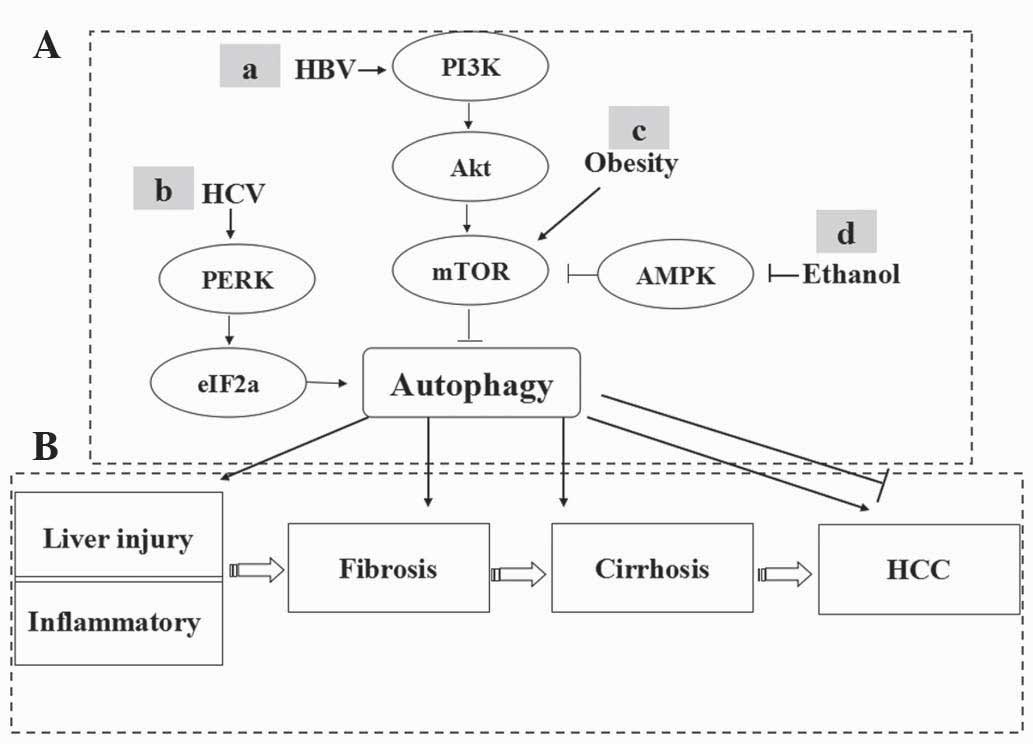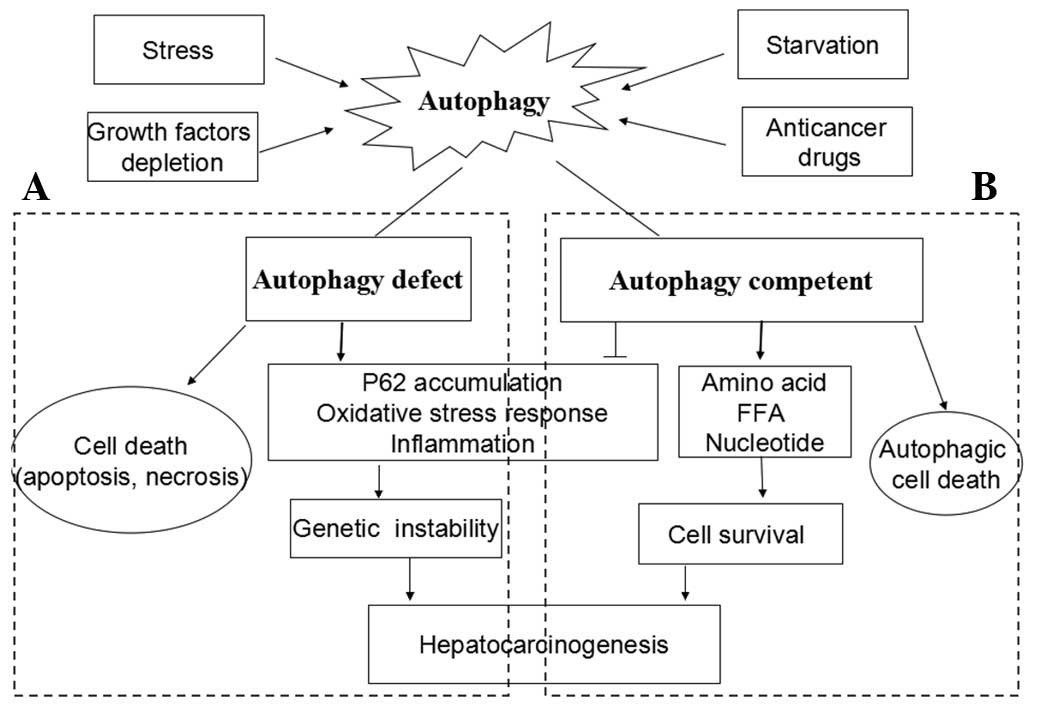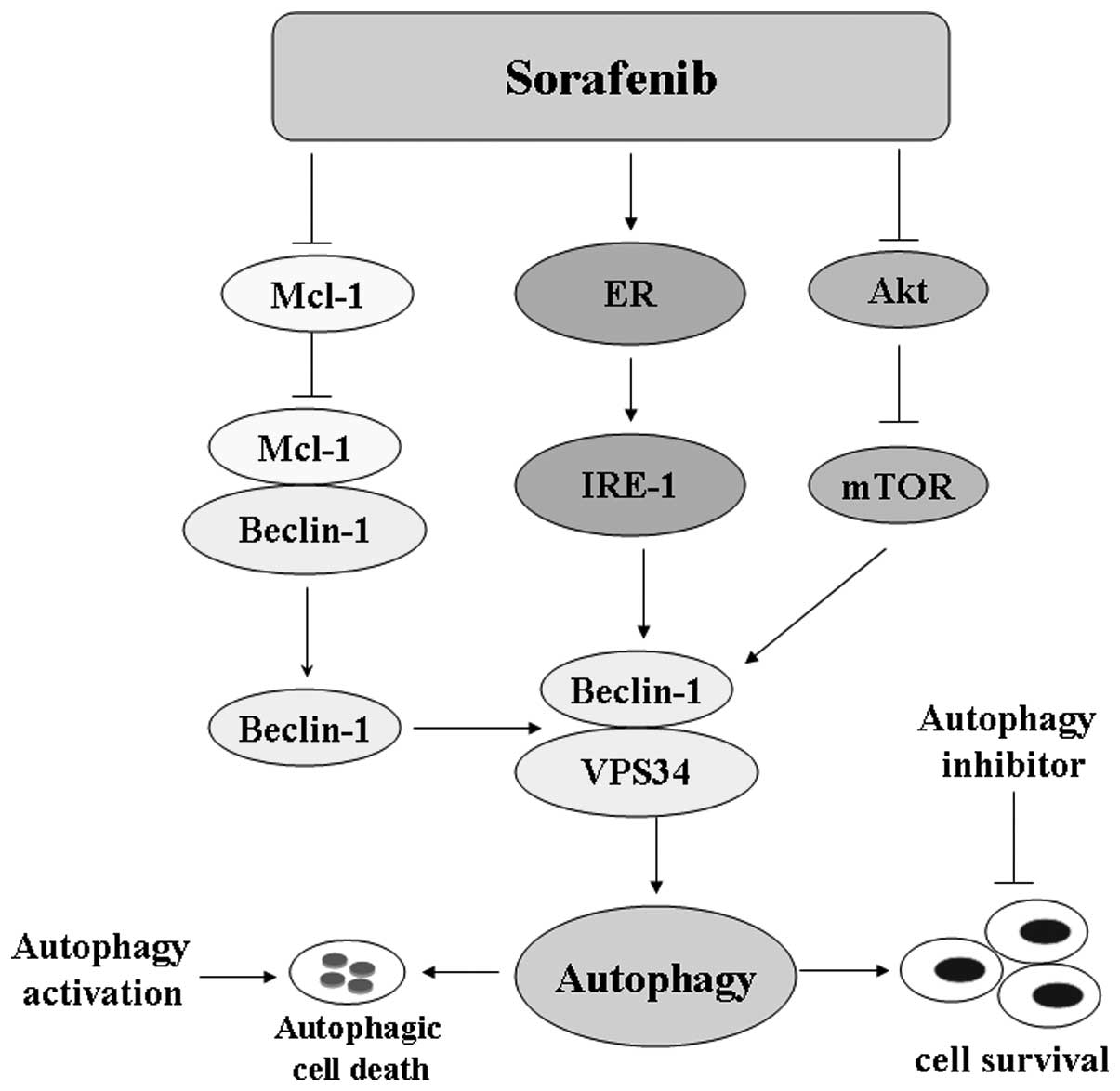Autophagy: A novel therapeutic target for hepatocarcinoma (Review)
- Authors:
- Zhanggui Wang
- Weidong Han
- Xinbing Sui
- Yong Fang
- Hongming Pan
-
Affiliations: Department of Medical Oncology, Sir Run Run Shaw Hospital, Zhejiang University, Hangzhou, Zhejiang 310016, P.R. China - Published online on: February 26, 2014 https://doi.org/10.3892/ol.2014.1916
- Pages: 1345-1351
This article is mentioned in:
Abstract
 |
 |
 |
|
Degenhardt K, Mathew R, Beaudoin B, et al: Autophagy promotes tumor cell survival and restricts necrosis, inflammation, and tumorigenesis. Cancer Cell. 10:51–64. 2006. View Article : Google Scholar : PubMed/NCBI | |
|
Kroemer G, Marino G and Levine B: Autophagy and the integrated stress response. Mol Cell. 40:280–293. 2010. View Article : Google Scholar : PubMed/NCBI | |
|
Rosenfeldt MT and Ryan KM: The multiple roles of autophagy in cancer. Carcinogenesis. 32:955–963. 2011. View Article : Google Scholar : PubMed/NCBI | |
|
Mizushima N: Autophagy: process and function. Genes Dev. 21:2861–2873. 2007. View Article : Google Scholar | |
|
Yue Z: Regulation of neuronal autophagy in axon: implication of autophagy in axonal function and dysfunction/degeneration. Autophagy. 3:139–141. 2007. View Article : Google Scholar : PubMed/NCBI | |
|
Scharl M and Rogler G: Inflammatory bowel disease: dysfunction of autophagy? Dig Dis. 30(Suppl 3): 12–19. 2012. View Article : Google Scholar | |
|
Yamaguchi O and Otsu K: Role of autophagy in aging. J Cardiovasc Pharmacol. 60:242–247. 2012. View Article : Google Scholar | |
|
Eskelinen EL: The dual role of autophagy in cancer. Curr Opin Pharmacol. 11:294–300. 2011. View Article : Google Scholar : PubMed/NCBI | |
|
Liang C and Jung JU: Autophagy genes as tumor suppressors. Curr Opin Cell Biol. 22:226–233. 2010. View Article : Google Scholar : PubMed/NCBI | |
|
Yang JD and Roberts LR: Hepatocellular carcinoma: a global view. Nat Rev Gastroenterol Hepatol. 7:448–458. 2010. View Article : Google Scholar : PubMed/NCBI | |
|
Fares N and Peron JM: Epidemiology, natural history, and risk factors of hepatocellular carcinoma. Rev Prat. 63:216–217. 2013.(In French). | |
|
Guerrieri F, Belloni L, Pediconi N, et al: Molecular mechanisms of HBV-associated hepatocarcinogenesis. Semin Liver Dis. 33:147–156. 2013. View Article : Google Scholar : PubMed/NCBI | |
|
Yamazaki K, Masugi Y and Sakamoto M: Molecular pathogenesis of hepatocellular carcinoma: altering transforming growth factor-beta signaling in hepatocarcinogenesis. Dig Dis. 29:284–288. 2011. View Article : Google Scholar | |
|
Maillard E: Epidemiology, natural history and pathogenesis of hepatocellular carcinoma. Cancer Radiother. 15:3–6. 2011.(In French). | |
|
Ni HM, Williams JA, Yang H, et al: Targeting autophagy for the treatment of liver diseases. Pharmacol Res. 66:463–474. 2012. View Article : Google Scholar : PubMed/NCBI | |
|
Cui J, Gong Z and Shen HM: The role of autophagy in liver cancer: molecular mechanisms and potential therapeutic targets. Biochim Biophys Acta. 1836:15–26. 2013.PubMed/NCBI | |
|
Rautou PE, Mansouri A, Lebrec D, et al: Autophagy in liver diseases. J Hepatol. 53:1123–1134. 2010. View Article : Google Scholar | |
|
Cabibbo G, Maida M, Genco C, et al: Natural history of untreatable hepatocellular carcinoma: a retrospective cohort study. World J Hepatol. 4:256–261. 2012. View Article : Google Scholar | |
|
Singh R, Kaushik S, Wang Y, et al: Autophagy regulates lipid metabolism. Nature. 458:1131–1135. 2009. View Article : Google Scholar : PubMed/NCBI | |
|
Dolganiuc A, Thomes PG, Ding WX, et al: Autophagy in alcohol-induced liver diseases. Alcohol Clin Exp Res. 36:1301–1308. 2012. View Article : Google Scholar : PubMed/NCBI | |
|
Ding WX, Li M and Yin XM: Selective taste of ethanol-induced autophagy for mitochondria and lipid droplets. Autophagy. 7:248–249. 2011. View Article : Google Scholar : PubMed/NCBI | |
|
Lavanchy D: Hepatitis B virus epidemiology, disease burden, treatment, and current and emerging prevention and control measures. J Viral Hepat. 11:97–107. 2004. View Article : Google Scholar : PubMed/NCBI | |
|
Beasley RP: Hepatitis B virus. The major etiology of hepatocellular carcinoma. Cancer. 61:1942–1956. 1988. View Article : Google Scholar : PubMed/NCBI | |
|
Sir D, Tian Y, Chen WL, et al: The early autophagic pathway is activated by hepatitis B virus and required for viral DNA replication. Proc Natl Acad Sci USA. 107:4383–4388. 2010. View Article : Google Scholar | |
|
Tian Y, Sir D, Kuo CF, et al: Autophagy required for hepatitis B virus replication in transgenic mice. J Virol. 85:13453–13456. 2011. View Article : Google Scholar : PubMed/NCBI | |
|
Tang H, Da L, Mao Y, et al: Hepatitis B virus X protein sensitizes cells to starvation-induced autophagy via up-regulation of beclin 1 expression. Hepatology. 49:60–71. 2009. View Article : Google Scholar : PubMed/NCBI | |
|
Shinohara Y, Imajo K, Yoneda M, et al: Unfolded protein response pathways regulate Hepatitis C virus replication via modulation of autophagy. Biochem Biophys Res Commun. 432:326–332. 2013. View Article : Google Scholar | |
|
Sir D, Kuo CF, Tian Y, et al: Replication of hepatitis C virus RNA on autophagosomal membranes. J Biol Chem. 287:18036–18043. 2012. View Article : Google Scholar : PubMed/NCBI | |
|
Shrivastava S, Bhanja Chowdhury J, Steele R, et al: Hepatitis C virus upregulates Beclin1 for induction of autophagy and activates mTOR signaling. J Virol. 86:8705–8712. 2012. View Article : Google Scholar : PubMed/NCBI | |
|
Dreux M, Gastaminza P, Wieland SF and Chisari FV: The autophagy machinery is required to initiate hepatitis C virus replication. Proc Natl Acad Sci USA. 106:14046–14051. 2009. View Article : Google Scholar : PubMed/NCBI | |
|
Thoen LF, Guimaraes EL, Dolle L, et al: A role for autophagy during hepatic stellate cell activation. J Hepatol. 55:1353–1360. 2011. View Article : Google Scholar | |
|
Fang H, Liu A, Dahmen U and Dirsch O: Dual role of chloroquine in liver ischemia reperfusion injury: reduction of liver damage in early phase, but aggravation in late phase. Cell Death Dis. 4:e6942013. View Article : Google Scholar | |
|
Yang JD, Seol SY, Leem SH, et al: Genes associated with recurrence of hepatocellular carcinoma: integrated analysis by gene expression and methylation profiling. J Korean Med Sci. 26:1428–1438. 2011. View Article : Google Scholar : PubMed/NCBI | |
|
Kim JH, Kim HY, Lee YK, et al: Involvement of mitophagy in oncogenic K-Ras-induced transformation: overcoming a cellular energy deficit from glucose deficiency. Autophagy. 7:1187–1198. 2011. View Article : Google Scholar : PubMed/NCBI | |
|
Rosenfeldt MT and Ryan KM: The role of autophagy in tumour development and cancer therapy. Expert Rev Mol Med. 11:e362009. View Article : Google Scholar : PubMed/NCBI | |
|
Qu X, Yu J, Bhagat G, et al: Promotion of tumorigenesis by heterozygous disruption of the beclin 1 autophagy gene. J Clin Invest. 112:1809–1820. 2003. View Article : Google Scholar : PubMed/NCBI | |
|
Kotsafti A, Farinati F, Cardin R, et al: Autophagy and apoptosis-related genes in chronic liver disease and hepatocellular carcinoma. BMC Gastroenterol. 12:1182012. View Article : Google Scholar : PubMed/NCBI | |
|
Takamura A, Komatsu M, Hara T, et al: Autophagy-deficient mice develop multiple liver tumors. Genes Dev. 25:795–800. 2011. View Article : Google Scholar : PubMed/NCBI | |
|
Guo XL, Li D, Hu F, et al: Targeting autophagy potentiates chemotherapy-induced apoptosis and proliferation inhibition in hepatocarcinoma cells. Cancer Lett. 320:171–179. 2012. View Article : Google Scholar : PubMed/NCBI | |
|
Uhm JE, Park JO, Lee J, et al: A phase II study of oxaliplatin in combination with doxorubicin as first-line systemic chemotherapy in patients with inoperable hepatocellular carcinoma. Cancer Chemother Pharmacol. 63:929–935. 2009. View Article : Google Scholar : PubMed/NCBI | |
|
Ding ZB, Hui B, Shi YH, et al: Autophagy activation in hepatocellular carcinoma contributes to the tolerance of oxaliplatin via reactive oxygen species modulation. Clin Cancer Res. 17:6229–6238. 2011. View Article : Google Scholar : PubMed/NCBI | |
|
Manov I, Pollak Y, Broneshter R and Iancu TC: Inhibition of doxorubicin-induced autophagy in hepatocellular carcinoma Hep3B cells by sorafenib - the role of extracellular signal-regulated kinase counteraction. FEBS J. 278:3494–3507. 2011. View Article : Google Scholar | |
|
Huynh H, Nguyen TT, Chow KH, et al: Over-expression of the mitogen-activated protein kinase (MAPK) kinase (MEK)-MAPK in hepatocellular carcinoma: its role in tumor progression and apoptosis. BMC Gastroenterol. 3:192003. View Article : Google Scholar : PubMed/NCBI | |
|
Wilhelm S, Carter C, Lynch M, et al: Discovery and development of sorafenib: a multikinase inhibitor for treating cancer. Nat Rev Drug Discov. 5:835–844. 2006. View Article : Google Scholar : PubMed/NCBI | |
|
Zhang X, Yang XR, Huang XW, et al: Sorafenib in treatment of patients with advanced hepatocellular carcinoma: a systematic review. Hepatobiliary Pancreat Dis Int. 11:458–466. 2012. View Article : Google Scholar : PubMed/NCBI | |
|
Xie B, Wang DH and Spechler SJ: Sorafenib for treatment of hepatocellular carcinoma: a systematic review. Dig Dis Sci. 57:1122–1129. 2012. View Article : Google Scholar : PubMed/NCBI | |
|
Shimizu S, Takehara T, Hikita H, et al: Inhibition of autophagy potentiates the antitumor effect of the multikinase inhibitor sorafenib in hepatocellular carcinoma. Int J Cancer. 131:548–557. 2012. View Article : Google Scholar | |
|
Shi YH, Ding ZB, Zhou J, et al: Targeting autophagy enhances sorafenib lethality for hepatocellular carcinoma via ER stress-related apoptosis. Autophagy. 7:1159–1172. 2011. View Article : Google Scholar : PubMed/NCBI | |
|
Hayashi-Nishino M, Fujita N, Noda T, et al: A subdomain of the endoplasmic reticulum forms a cradle for autophagosome formation. Nat Cell Biol. 11:1433–1437. 2009. View Article : Google Scholar : PubMed/NCBI | |
|
Hui B, Shi YH, Ding ZB, et al: Proteasome inhibitor interacts synergistically with autophagy inhibitor to suppress proliferation and induce apoptosis in hepatocellular carcinoma. Cancer. 118:5560–5571. 2012. View Article : Google Scholar : PubMed/NCBI | |
|
Yu HC, Hou DR, Liu CY, et al: Cancerous inhibitor of protein phosphatase 2A mediates bortezomib-induced autophagy in hepatocellular carcinoma independent of proteasome. PLoS One. 8:e557052013. View Article : Google Scholar | |
|
Guo XL, Li D, Sun K, et al: Inhibition of autophagy enhances anticancer effects of bevacizumab in hepatocarcinoma. J Mol Med (Berl). 91:473–483. 2013. View Article : Google Scholar : PubMed/NCBI | |
|
Tai WT, Shiau CW, Chen HL, et al: Mcl-1-dependent activation of Beclin 1 mediates autophagic cell death induced by sorafenib and SC-59 in hepatocellular carcinoma cells. Cell Death Dis. 4:e4852013. View Article : Google Scholar | |
|
Gao M, Yeh PY, Lu YS, et al: OSU-03012, a novel celecoxib derivative, induces reactive oxygen species-related autophagy in hepatocellular carcinoma. Cancer Res. 68:9348–9357. 2008. View Article : Google Scholar | |
|
Yu HC, Lin CS, Tai WT, et al: Nilotinib induces autophagy in hepatocellular carcinoma through AMPK activation. J Biol Chem. 288:18249–18259. 2013. View Article : Google Scholar : PubMed/NCBI | |
|
Soliman H, Ringash J, Jiang H, et al: Phase II trial of palliative radiotherapy for hepatocellular carcinoma and liver metastases. J Clin Oncol. 31:3980–3986. 2013. View Article : Google Scholar : PubMed/NCBI | |
|
Anbalagan S, Pires IM, Blick C, et al: Radiosensitization of renal cell carcinoma in vitro through the induction of autophagy. Radiother Oncol. 103:388–393. 2012. View Article : Google Scholar : PubMed/NCBI | |
|
Cerniglia GJ, Karar J, Tyagi S, et al: Inhibition of autophagy as a strategy to augment radiosensitization by the dual phosphatidylinositol 3-kinase/mammalian target of rapamycin inhibitor NVP-BEZ235. Mol Pharmacol. 82:1230–1240. 2012. View Article : Google Scholar : PubMed/NCBI | |
|
Bristol ML, Di X, Beckman MJ, et al: Dual functions of autophagy in the response of breast tumor cells to radiation: cytoprotective autophagy with radiation alone and cytotoxic autophagy in radiosensitization by vitamin D 3. Autophagy. 8:739–753. 2012. View Article : Google Scholar | |
|
Wilson EN, Bristol ML, Di X, et al: A switch between cytoprotective and cytotoxic autophagy in the radiosensitization of breast tumor cells by chloroquine and vitamin D. Horm Cancer. 2:272–285. 2011. View Article : Google Scholar : PubMed/NCBI | |
|
Altmeyer A, Jung AC, Ignat M, et al: Pharmacological enhancement of autophagy induced in a hepatocellular carcinoma cell line by high-LET radiation. Anticancer Res. 30:303–310. 2010.PubMed/NCBI | |
|
Altmeyer A, Ignat M, Denis JM, et al: Cell death after high-LET irradiation in orthotopic human hepatocellular carcinoma in vivo. In Vivo. 25:1–9. 2011. | |
|
Gao L, Song JR, Zhang JW, et al: Chloroquine promotes the anticancer effect of TACE in a rabbit VX2 liver tumor model. Int J Biol Sci. 9:322–330. 2013. View Article : Google Scholar : PubMed/NCBI | |
|
Ochsner M: Photophysical and photobiological processes in the photodynamic therapy of tumours. J Photochem Photobiol B. 39:1–18. 1997. View Article : Google Scholar : PubMed/NCBI | |
|
Andrzejak M, Price M and Kessel DH: Apoptotic and autophagic responses to photodynamic therapy in 1c1c7 murine hepatoma cells. Autophagy. 7:979–984. 2011. View Article : Google Scholar : PubMed/NCBI | |
|
Arum CJ, Anderssen E, Viset T, et al: Cancer immunoediting from immunosurveillance to tumor escape in microvillus-formed niche: a study of syngeneic orthotopic rat bladder cancer model in comparison with human bladder cancer. Neoplasia. 12:434–442. 2010. | |
|
Liang X, De Vera ME, Buchser WJ, et al: Inhibiting systemic autophagy during interleukin 2 immunotherapy promotes long-term tumor regression. Cancer Res. 72:2791–2801. 2012. View Article : Google Scholar | |
|
Li P, Du Q, Cao Z, et al: Interferon-gamma induces autophagy with growth inhibition and cell death in human hepatocellular carcinoma (HCC) cells through interferon-regulatory factor-1 (IRF-1). Cancer Lett. 314:213–222. 2012. View Article : Google Scholar | |
|
Su S, Zhou H, Xue M, et al: Anti-tumor efficacy of a hepatocellular carcinoma vaccine based on dendritic cells combined with tumor-derived autophagosomes in murine models. Asian Pac J Cancer Prev. 14:3109–3116. 2013. View Article : Google Scholar | |
|
Leithead JA, Armstrong MJ, Corbett C, et al: Hepatic ischemia reperfusion injury is associated with acute kidney injury following donation after brain death liver transplantation. Transpl Int. 26:1116–1125. 2013. View Article : Google Scholar | |
|
Yasuda H, Leelahavanichkul A, Tsunoda S, et al: Chloroquine and inhibition of Toll-like receptor 9 protect from sepsis-induced acute kidney injury. Am J Physiol Renal Physiol. 294:F1050–F1058. 2008. View Article : Google Scholar : PubMed/NCBI | |
|
Hoshino A, Matoba S, Iwai-Kanai E, et al: p53-TIGAR axis attenuates mitophagy to exacerbate cardiac damage after ischemia. J Mol Cell Cardiol. 52:175–184. 2012. View Article : Google Scholar : PubMed/NCBI | |
|
Gotoh K, Lu Z, Morita M, et al: Participation of autophagy in the initiation of graft dysfunction after rat liver transplantation. Autophagy. 5:351–360. 2009. View Article : Google Scholar : PubMed/NCBI | |
|
Degli Esposti D, Sebagh M, Pham P, et al: Ischemic preconditioning induces autophagy and limits necrosis in human recipients of fatty liver grafts, decreasing the incidence of rejection episodes. Cell Death Dis. 2:e1112011. | |
|
Toso C, Merani S, Bigam DL, et al: Sirolimus-based immunosuppression is associated with increased survival after liver transplantation for hepatocellular carcinoma. Hepatology. 51:1237–1243. 2010. View Article : Google Scholar | |
|
Yang ZJ, Chee CE, Huang S and Sinicrope FA: The role of autophagy in cancer: therapeutic implications. Mol Cancer Ther. 10:1533–1541. 2011. View Article : Google Scholar : PubMed/NCBI | |
|
Toshima T, Shirabe K, Matsumoto Y, et al: Autophagy enhances hepatocellular carcinoma progression by activation of mitochondrial beta-oxidation. J Gastroenterol. May 24–2013.(Epub ahead of print). | |
|
Gozuacik D and Kimchi A: Autophagy as a cell death and tumor suppressor mechanism. Oncogene. 23:2891–2906. 2004. View Article : Google Scholar : PubMed/NCBI | |
|
Kanzawa T, Kondo Y, Ito H, et al: Induction of autophagic cell death in malignant glioma cells by arsenic trioxide. Cancer Res. 63:2103–2108. 2003. | |
|
Kim EH, Sohn S, Kwon HJ, et al: Sodium selenite induces superoxide-mediated mitochondrial damage and subsequent autophagic cell death in malignant glioma cells. Cancer Res. 67:6314–6324. 2007. View Article : Google Scholar | |
|
Dupere-Richer D, Kinal M, Menasche V, et al: Vorinostat-induced autophagy switches from a death-promoting to a cytoprotective signal to drive acquired resistance. Cell Death Dis. 4:e4862013. View Article : Google Scholar | |
|
Takahashi A, Kimura T, Takabatake Y, et al: Autophagy guards against cisplatin-induced acute kidney injury. Am J Pathol. 180:517–525. 2012. View Article : Google Scholar : PubMed/NCBI | |
|
Ching JK and Weihl CC: Rapamycin-induced autophagy aggravates pathology and weakness in a mouse model of VCP-associated myopathy. Autophagy. 9:799–800. 2013. View Article : Google Scholar |









